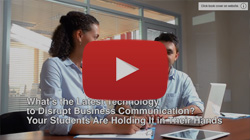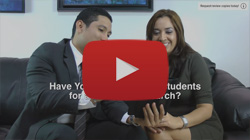
Methods of Teaching Business Communication
Gain unique insights into how to teach your business communication
course more successfully. Read More
Where’s the Empathy? Uber’s Icy Response Leaves Passengers Cold

Answers to Discussion Questions:
1. How could Uber's communication address controversies better? What strategies could rebuild trust and image?
Empathy and Transparency: Acknowledge concerns genuinely, expressing regret and outlining concrete steps to address issues.
Clear and Concise Language: Avoid jargon and technical terms, focusing on plain language that resonates with a broad audience.
Proactive Communication: Regularly update stakeholders on progress and demonstrate a commitment to improvement.
Multiple Channels: Utilize various communication channels (press releases, social media, direct communication) to reach diverse audiences.
Openness to Feedback: Actively listen to concerns and incorporate feedback into communication strategies.
2. What broader communication lessons can students learn from Uber's case? How can these lessons be applied in real-world situations?
Crisis communication planning: Develop clear communication protocols for various scenarios to ensure timely and effective responses.
Audience awareness: Tailor messages to specific stakeholders, considering their needs, concerns, and preferred communication channels.
Importance of tone and language: Choose respectful and empathetic language that fosters trust and understanding.
Transparency and accountability: Be honest about challenges and take responsibility for mistakes, demonstrating a commitment to learning and improvement.
Building trust through action: Translate communication into concrete actions that address concerns and demonstrate a commitment to positive change.
By understanding these lessons and applying them proactively, students can navigate challenging situations, build trust with stakeholders, and protect their organization's reputation.
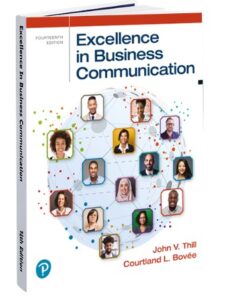 Excellence in Business Communication teaches students to communicate effectively, empathetically, and transparently, which could have helped Uber handle controversies better. The book emphasizes audience analysis, clear messaging, and active listening—crucial skills for addressing concerns genuinely.
Excellence in Business Communication teaches students to communicate effectively, empathetically, and transparently, which could have helped Uber handle controversies better. The book emphasizes audience analysis, clear messaging, and active listening—crucial skills for addressing concerns genuinely.
It also covers crisis communication, teaching students to take responsibility, express empathy, and outline corrective actions. Moreover, the book highlights the importance of aligning words with actions to build trust. By applying these principles, Uber could have fostered open dialogue, acknowledged issues, and clearly communicated steps to resolve them, thereby strengthening relationships with stakeholders.
The book equips students with the communication skills to navigate challenges and build trust.
Read moreThe Truth about Loyalty Programs: Customer Magnet or Pointless Pursuit?
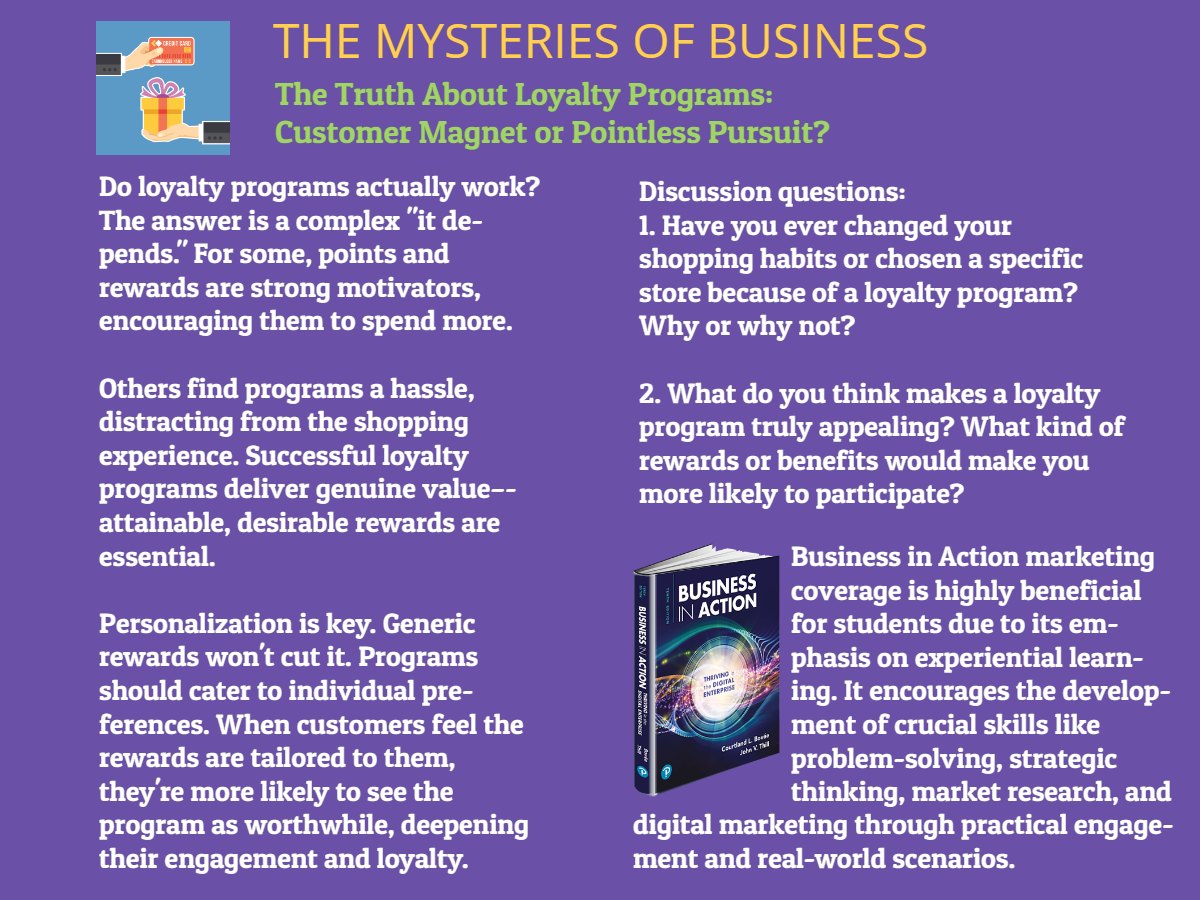
Here are my answers to the discussion questions:
- Have you ever changed your shopping habits or chosen a specific store because of a loyalty program? Why or why not?
Yes, I have changed my shopping habits and chosen specific stores because of their loyalty programs. For example, I frequently shop at a particular grocery store chain because of their rewards program, which offers points for every dollar spent that can be redeemed for discounts on gas or future purchases. I find this program valuable because the rewards are easy to earn and redeem, and they provide tangible savings on products I would buy anyway.
However, I have also avoided certain loyalty programs that felt too complicated or didn't offer rewards that were meaningful to me. I once signed up for a clothing store's loyalty program but never used it because the points system was confusing and the rewards didn't align with my shopping preferences.
- What do you think makes a loyalty program truly appealing? What kind of rewards or benefits would make you more likely to participate?
For me, a truly appealing loyalty program is one that offers:
- Simplicity: The program should be easy to understand and use, with clear rules for earning and redeeming rewards. Complicated points systems or excessive restrictions can be frustrating and discourage participation.
- Relevant rewards: The rewards offered should be things that I actually want or need. Discounts on products I regularly buy, exclusive access to sales or products, or even personalized recommendations based on my shopping history would all be appealing incentives.
- Attainable rewards: The rewards should feel achievable within a reasonable timeframe. If it takes an extremely long time or an unrealistic spending amount to earn a meaningful reward, I'm less likely to engage with the program.
- Flexibility: I appreciate loyalty programs that offer multiple ways to earn and redeem rewards, such as earning points through purchases, referrals, or engaging with the brand on social media, and the ability to choose from various reward options.
- Integration with my shopping experience: A loyalty program that seamlessly integrates with my typical shopping experience, such as a mobile app that tracks my points and offers personalized deals, would make me more likely to participate consistently.
Ultimately, a loyalty program that demonstrates a genuine understanding of my preferences and offers value that enhances my shopping experience would be most appealing and effective in securing my ongoing business.
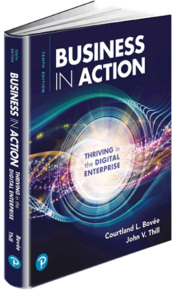 Business in Action is the ideal choice for any Introduction to Business instructor seeking to provide their students with a comprehensive, engaging, and practical learning experience. This textbook stands out for its clear and accessible writing style, which effectively explains complex business concepts in a way that resonates with students from diverse backgrounds. The content is carefully organized and updated to reflect the latest trends and challenges in the dynamic world of business, ensuring that students gain relevant and applicable knowledge.
Business in Action is the ideal choice for any Introduction to Business instructor seeking to provide their students with a comprehensive, engaging, and practical learning experience. This textbook stands out for its clear and accessible writing style, which effectively explains complex business concepts in a way that resonates with students from diverse backgrounds. The content is carefully organized and updated to reflect the latest trends and challenges in the dynamic world of business, ensuring that students gain relevant and applicable knowledge.
With its rich array of real-world examples, case studies, and practical applications, Business in Action helps students bridge the gap between theory and practice, fostering critical thinking, problem-solving, and decision-making skills that are essential for success in today's competitive business landscape. Moreover, the textbook's robust suite of supplementary materials, including online resources, such as the powerful MyLab (now supported by artificial intelligence), and interactive learning tools, enhances student engagement and supports various teaching styles. By choosing Business in Action, instructors can be confident that they are providing their students with a solid foundation for understanding the multifaceted nature of business and preparing them for the challenges and opportunities that await them in their future careers.
Read more
H&M’s “Conscious” Clothing: Sustainable Savior or Greenwashing Sham?

Discussion Questions and Answers:
1. Balancing Sustainability and Transparency:
Companies like H&M can avoid greenwashing by focusing on specific and verifiable claims about their sustainability initiatives. This includes providing data, using clear language, and avoiding vague terms like "eco-friendly" without explanation.
Transparency is key. Companies should disclose their entire environmental footprint, not just highlight selective positive aspects. This fosters trust and allows stakeholders to understand the ongoing efforts and areas for improvement.
Focus on progress, not perfection. Communicating concrete steps taken and measurable goals for the future demonstrates genuine commitment, even if the journey is ongoing.
2. Bridging the Gap and Managing Expectations:
Acknowledge the inherent challenges of their business model and its impact on sustainability goals. Honesty builds trust and avoids misleading portrayals.
Focus on long-term vision and commitment to evolving the business model towards greater sustainability. Outline concrete steps and timelines for progress.
Engage in open dialogue with stakeholders like consumers, environmental groups, and investors. This allows for feedback, fosters collaboration, and helps manage expectations.
Use communication strategically to educate consumers about the complexities of achieving sustainability in their industry. This fosters understanding and avoids unrealistic expectations.
By implementing these strategies, companies like H&M can navigate the complex landscape of sustainability communication, build trust with stakeholders, and avoid the pitfalls of greenwashing.
How the Excellence in Business Communication Addresses This Scenario
Excellence in Business Communication includes several core concepts directly relevant to the H&M case. Here's how those concepts might be explained:
-
Ethical Communication: The concept of balancing transparency with promotional messaging in the context of sustainability relates directly to ethical business communication. The textbook covers:
- Identifying misleading or exaggerated claims.
- The importance of truthfulness and avoiding deceptive practices.
- How to back up claims with reliable data and evidence.
-
Balancing Stakeholder Interests: This textbook explores the need to consider and address the viewpoints of multiple stakeholders. H&M must balance the messaging for:
- Environmentally conscious consumers: Expect transparency and genuine change.
- General consumers: May focus on price and trends.
- Shareholders: Desire profitability and growth.
- Employees: Seek job security, fair treatment, and a company they believe in.
-
Navigating Complex Expectations: Communicating sustainability in an era of intense scrutiny falls under this category. The textbook covers:
- Audience analysis: How to understand different groups' values and communication preferences.
- Crisis communication: Proactively addressing potential criticisms or accusations of greenwashing.
- Reputation management: Building long-term trust through consistent, values-driven messaging.
Key Lessons for Business Communication Students
The H&M case presents a valuable real-world scenario that highlights several critical lessons from the world of business communication:
- The Power (and Risk) of Sustainability Claims: Sustainability is a major selling point, but audiences are vigilant against greenwashing.
- Transparency is Not Optional: Companies must be willing to be open about successes and shortcomings, acknowledging the complexities involved.
- Ethical Dilemmas are Inherent: Businesses often operate with competing interests and imperfect solutions, requiring careful message balancing.
- Nuance Matters: Simple "good vs. bad" narratives don't capture the reality of corporate efforts. Students must learn to communicate progress and plans without misleading.
Lost in Rome, Ignored at Home: CEO Finally Answers After Online Shaming Storm
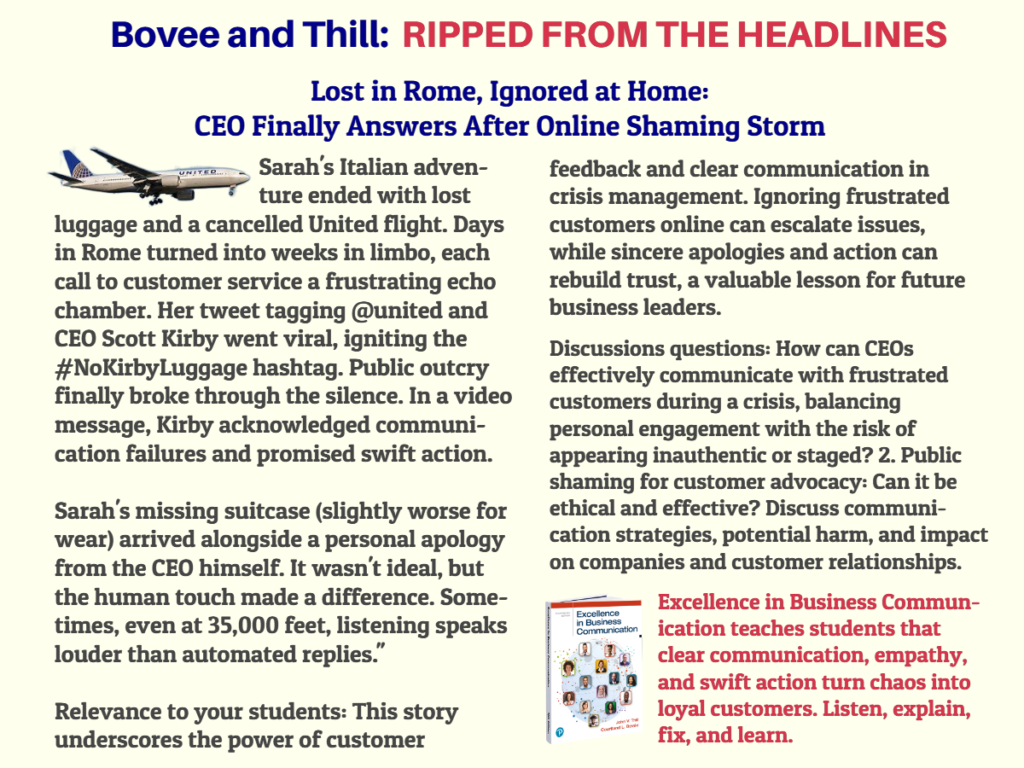 ANSWERS TO DISCUSSION QUESTIONS
ANSWERS TO DISCUSSION QUESTIONS
1. How can CEOs effectively communicate with frustrated customers during a crisis, balancing personal engagement with the risk of appearing inauthentic or staged?
Balancing act: CEOs need to find a middle ground between:
Authentic empathy: Showing genuine understanding and concern for the customer's situation.
Transparency and accountability: Acknowledging mistakes and outlining concrete steps to resolve the issue.
Maintaining professionalism: Avoiding excessive drama or apologies that sound scripted.
Effective strategies:
Respond promptly and publicly: Acknowledge the issue on social media or relevant platforms where the customer raised it.
Express genuine empathy: Use sincere language that validates the customer's frustration.
Offer specific solutions: Explain what is being done to address the issue and provide a timeline for resolution.
Be transparent: Share details without making excuses or blaming others.
Listen and engage: Encourage further communication and answer questions openly.
Personalize the response: If appropriate, a personal apology from the CEO can demonstrate commitment.
Avoiding inauthenticity:
Be consistent with past actions: Actions must match words to avoid appearing disingenuous.
Avoid scripted language: Use genuine and personalized language.
Focus on solutions, not excuses: Don't blame external factors or deflect responsibility.
Stay professional: Avoid emotional outbursts or unprofessional language.
2. Public shaming for customer advocacy: Can it be ethical and effective? Discuss communication strategies, potential harm, and impact on companies and customer relationships.
Ethical considerations:
Proportionality: The severity of the shaming should be proportional to the offense.
Targeting: Aim criticism at the responsible party, not innocent individuals.
Accuracy: Ensure information shared is accurate and verifiable.
Intent: Avoid personal attacks and focus on constructive criticism.
Potential harm:
Reputational damage to company and individuals: Can go beyond the specific issue and harm innocent employees.
Escalation of conflict: Can create hostility and make resolution more difficult.
Unintended consequences: May impact other customers and employees negatively.
Effective communication strategies:
Focus on facts and evidence: Present a clear and factual account of the issue.
Direct criticism responsibly: Target the relevant parties and avoid personal attacks.
Seek constructive solutions: Propose solutions and engage in dialogue with the company.
Maintain respectful communication: Avoid inflammatory language and harassment.
Impact on companies and customer relationships:
Can pressure companies to take action: Public shaming can be a powerful tool for change.
Can damage customer trust: If mishandled, it can alienate customers and harm relationships.
Can create fear and silence: Fear of public shaming can deter legitimate customer complaints.
Overall, public shaming can be a double-edged sword. It can be effective in driving change, but it's crucial to consider the ethical implications, potential harm, and responsible communication strategies before resorting to it.
Remember, the goal is to achieve a fair and just resolution, not simply inflict harm. Encourage students to consider alternative approaches like direct communication, formal complaints, or seeking media attention through ethical channels before resorting to public shaming.
Read moreA Personal Note from Court Bovee and John Thill
Subject: The Thrill of Business Communication in a Dynamic World
Exciting times lie ahead for business communication educators! Current events constantly offer real-world examples that can motivate and energize students, propelling them towards even greater success.
We understand the challenge of incorporating real-world scenarios into your curriculum. That's why in upcoming posts I'll be providing a selection of the posts mentioned below, featuring actual companies, their communication challenges, and suggested discussion prompts with insightful answers.
We believe this practical approach is key to successful teaching. My coauthor and I have always integrated numerous real-world examples from diverse companies within our textbooks. However, my LinkedIn content will stand out for its immediacy. That's why I'm launching a series titled "Ripped from the Headlines."
Get a sneak peek at upcoming titles:
How Airbus Mastered Multilingual Communication
Effective Communication Saved the Day at Amazon
Dropbox: Leveraging Communication for Remote Collaboration
Domino's: Mastering the Art of Business Communication
Peloton Found Its Rhythm Through Business Communication
Uber: The Impact of Business Communication on Conflict
Five Lessons in Business Communication (the Hard Way): Equifax
Ikea's Recipe for Global Harmony
In a separate series called "Optimize Your Business Communication Instruction," I'll share the latest research findings on essential topics like visual communication, algorithms, business writing, interviewing and resumes, social media, listening, email, and reports.
Recognizing the complexities of business communication, I've created "The Mysteries of Business Communication" series. Dive into topics like:
The Body Language Enigma
The Power of Tone
The Nonverbal Void
The Power of Silence
Grasping Speaker Intent and Emotions
The Charisma Conundrum
Join the discussion in "What Do You Think," a thought-provoking series exploring:
Caught Between a Clock and a Camera: The Employee's Privacy Paradox
Like It or Like It Not: Navigating the Social Media Tightrope
Ha-Ha, or Huh-Oh: Office Humor's Minefield
In-Box Obituary: Is Email Dead or Evolving?
Finally, "Bovee & Thill Playbook: Unmasking the Secrets of Business Communication in 2024" offers insights into:
The Magic of AI and Visuals in Messaging
Presentation Skills with Next-Gen Performance Solutions
The Trojan Horse of the Mind: Why Stories Conquer (and Win Hearts)
Emotional Insights at the Speed of Light: Microexpressions
As pioneers in covering digital communication in business communication textbooks, we were the first to cover social media, mobile communication, and artificial intelligence. Naturally, our most extensive coverage of AI appears in the highly acclaimed 14th edition of "Excellence in Business Communication." We appreciate the positive feedback it has received and encourage you to explore it yourself. You can obtain an examination copy by clicking here.
Want to receive these posts as soon as they're published? Join my group, Teaching Business Communication, on LinkedIn! Over 3,400 members enjoy weekly updates and engage in discussions. Click here to join.
All the best,
Court Bovee
John Thill
Cardi B, Kim K, and the Price of Poor Disclosure: A Business Communication Lesson
 ANSWERS:
ANSWERS:
Here's a breakdown of the questions and how to approach answers, considering some ethical complexities involved:
Question 1: Does pairing health-focused products with popular influencers create a false sense of scientific legitimacy or medical endorsement?
Yes, it often can. Many influencers don't have qualifications in health, nutrition, or medicine. Their popularity arises from other factors (aesthetics, entertainment value, etc.). When they promote health products, it can mislead audiences into thinking there's more scientific backing than there is.
The "Halo Effect": We trust people we like or find attractive. Their presence alongside a product makes us favorably disposed towards it, even without solid evidence.
Companies intentionally do this: They know influencers will boost sales even if the influencer lacks genuine expertise.
Question 2: How can companies avoid this perception?
Transparency: Clear disclaimers that an influencer is not a medical professional, and their statements shouldn't replace advice from a doctor.
Vetting: Work with influencers who align with evidence-based health practices. Someone selling detox teas is probably not a great choice if a company truly cares about the science behind their products
Tone Down Claims: Instead of making big promises, focus on how a product might fit into a balanced lifestyle. Avoid sounding like the influencer is prescribing medication.
Question 3: When should influencers refuse lucrative partnership opportunities due to ethical concerns surrounding the product or messaging?
This is a personal line each influencer must draw, but here are situations where refusal is likely warranted:
Conflicts of Interest: If the product goes against the influencer's normally stated beliefs (e.g., a vegan influencer promoting a meat-heavy diet for money).
Dishonesty: When the influencer knows the claims about the product are deceptive or exaggerated.
Potential Harm: If there are known risks associated with the product, especially if the influencer's followers are a particularly vulnerable demographic.
Gut Feeling: If something makes them genuinely uncomfortable, even if they can't pinpoint the exact reason, sometimes listening to one's internal ethical compass is necessary.
Additional Thoughts
Regulation is lacking in this space, allowing dubious practices to continue. Consumers and influencers themselves need to be aware of these marketing tactics.
Critical thinking is needed by consumers. Don't trust health claims from someone just because they're famous or look fit.
Fame doesn't equal knowledge. A huge following does not equal medical expertise.
By dissecting real-world situations like these, and as in done in Excellence in Business Communication, 14th Edition, business communication students learn to think critically about messaging, ethics, and audience perception. They recognize the power of persuasive techniques and identify instances where those techniques cross into manipulation. Analyzing "ripped from the headlines" scenarios demonstrates the real risks when communication goes wrong, preparing students to become thoughtful and responsible communication professionals.
————————————————————————————————————————————————————————-
Subject: Spark Student Interest in Business Communication with "Ripped from the Headlines" Discussions
Dear Business Communication Instructor,
Want to prove your subject matter isn't just theory? This newsletter links your lessons to THIS WEEK'S news – crisis communication fails, deepfakes, AI blunders, and more. It's packed with ready-to-use talking points to show students how their business communication skills will be essential in their future careers.
This headline supercharges student motivation with these key strategies:
Extrinsic Motivation: It directly links course material to potential career consequences, acting as an extrinsic motivator. Students understand that business communication isn't just about grades, but about real-world success.
Intrinsic Motivation: Analyzing current events and engaging in lively discussions fosters intrinsic motivation. This makes learning enjoyable and builds a positive association with the subject matter.
Relevance-Based Motivation: Demonstrating how current headlines relate to core concepts enhances motivation. Students see the subject as important and timely, boosting interest and engagement.
Need to streamline your lesson planning? This newsletter does the prep work for you! Each story links to a key business communication concept and includes thought-provoking discussion questions. We hope this makes your classes the ones students can't stop talking about!
This dynamic teaching is made possible with Excellence in Business Communication, a textbook that stands out with its unmatched focus on real-world skills and the rapidly evolving digital landscape. It features current headlines, explores the complexities of AI and deepfakes, and prioritizes ethical, adaptable communication in a way no other textbook does.
This contemporary approach means students won't just learn theories–they'll tackle the problems facing today's businesses. Emphasis on critical thinking and audience analysis prepares them to adapt to communication challenges on the horizon. With "Excellence," lessons transcend the classroom, ensuring graduates enter the workforce with a competitive edge.
The emphasis on building trust and authenticity in this era of heightened skepticism reinforces the value of true connection alongside technological efficiency. This is why Excellence in Business Communication is being so widely adopted by business communication instructors in 2024.
See the brochure for Excellence in Business Communication, 14th Edition: Video: . How Does Your Text Compare? . To request examination copies of Bovee and Thill's award-winning business communication textbooks (instructors only), visit this ordering page.
Read moreGenerative AI in the Business Communication Curriculum: Where Do We Go From Here?
 As we’ve been tracking the development of intelligent communication technologies in our recent editions, augmented and automated writing systems have been the most intriguing innovation of them all. ChatGPT received most of the attention when OpenAI unleashed it on a mostly unsuspecting world last fall, but several hundred companies are now developing tools that promise to create or co-create anything from routine email messages and social media content to podcasts, presentations, and videos.
As we’ve been tracking the development of intelligent communication technologies in our recent editions, augmented and automated writing systems have been the most intriguing innovation of them all. ChatGPT received most of the attention when OpenAI unleashed it on a mostly unsuspecting world last fall, but several hundred companies are now developing tools that promise to create or co-create anything from routine email messages and social media content to podcasts, presentations, and videos.
While the AI industry is clearly in the overheated early-hype phase with some of these products, intelligent capabilities are now widely available in the mainstream tools people use on the job, so it’s safe to say that generative AI technologies are on their way to becoming everyday business communication tools. With that in mind, it’s time to start teaching tomorrow’s professionals how to use them effectively and ethically—as we know many of you are already doing.
Looking ahead to the next edition of Business Communication Today we’ll be working on in the coming months, which topics would you like to see us cover? Here are some of the topics we’re considering:
- Understanding the various roles that AI now has in workplace communication
- Using AI efficiently, including tips on framing AI prompts
- Learning specific ways to use AI for business communication, from co-creation to proofreading to technical aspects of media production
- Assessing information quality risks with AI-generated material, including accuracy (getting bad information), scope (missing important facts or facets of a topic), currency (getting outdated information), and nuance (getting output that is close but lacks important interpretation)
- Understanding ethical risks, including biases baked into AI systems and attribution issues surrounding the use of AI-generated content
- Understanding legal risks, such as misusing intellectual property or inappropriately uploading secure content into AI engines
- Dealing with the “soullessness” of AI-generated content and its potential impact on interpersonal communication
If you have any thoughts on how our textbooks can help you help students with these new tools, we would certainly value your input. Please share your thoughts at any of these venues:
- Facebook: Teaching Business Communication
- Facebook: Bovée and Thill's Inner Circle for Business Communication (reserved for college and university instructors who are adopters of Bovée and Thill textbooks)
- LinkedIn: Teaching Business Communication
- LinkedIn: Bovée & Thill’s Inner Circle for Business Communication (reserved for college and university instructors who are adopters of Bovée and Thill textbooks)
Image by MOMO36H10 HH from Pixabay
Read moreHow Artificial Intelligence Can Help Business Communication Instructors in Their Classrooms Using These Methods

Artificial intelligence (AI) is increasingly being used in college classrooms today and is having a significant impact in several interesting ways:
Personalized Learning: AI can be used to develop personalized learning algorithms for students, providing tailored instructions and feedback to help students learn at their own pace.
-
Data Analytics and Predictive Modelling: AI and data analytics technologies can analyze large amounts of student data, identifying patterns, and behaviors, that can help predict student performance and needs, improving the overall quality of the academic experience.
-
Intelligent Tutoring Systems: AI can simulate one-on-one tutoring, providing instant feedback, answering student questions, and providing personalized study recommendations.
-
Automated Grading: AI technology can grade assignments, reducing the workload on professors and allowing them to dedicate more attention to instruction, mentoring and promoting research.
-
Better Resource Allocation: AI-informed resource allocation in classrooms is possible, prioritizing equipment and resources to achieve the highest potential for student learning outcomes.
-
Assistance in Research and Data Analysis: AI can assist researchers and students in complex data analysis, leading to new discovery and generating new business insights.
Overall, AI technology has the potential to significantly transform the college classroom, making it more personalized, productive, accessible, and inclusive for everyone involved.
However, the implementation of AI must be approached carefully, in a holistic, comprehensive, and beneficially ethical manner. Instructors and educational stakeholders must also ensure proper guidelines and privacy frameworks are in place to protect student data and privacy while leveraging the potential of AI.
For more details about this topic, see 43 Examples of Artificial Intelligence in Education.
To teach your students about artificial intelligence and intelligent technologies, check out Excellence in Business or Business Communication Today at https://lnkd.in/bvxGGmT.
Read more
